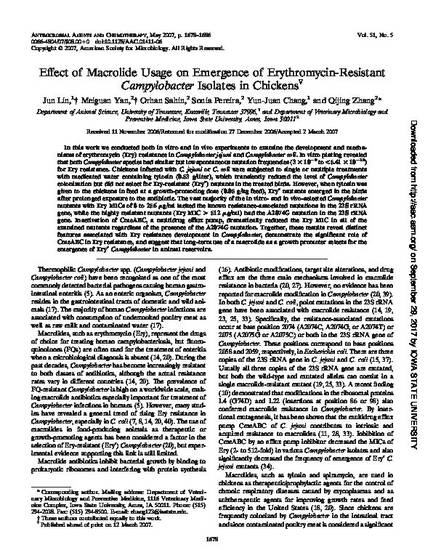
Article
Effect of Macrolide Usage on Emergence of Erythromycin-Resistant Campylobacter Isolates in Chickens
Antimicrobial Agents and Chemotherapy
Document Type
Article
Disciplines
Publication Version
Published Version
Publication Date
5-1-2007
DOI
10.1128/AAC.01411-06
Abstract
In this work we conducted both in vitro and in vivo experiments to examine the development and mechanisms of erythromycin (Ery) resistance in Campylobacter jejuni and Campylobacter coli. In vitro plating revealed that both Campylobacter species had similar but low spontaneous mutation frequencies (3 × 10−9 to −10) for Ery resistance. Chickens infected with C. jejuni or C. coli were subjected to single or multiple treatments with medicated water containing tylosin (0.53 g/liter), which transiently reduced the level of Campylobacter colonization but did not select for Ery-resistant (Eryr) mutants in the treated birds. However, when tylosin was given to the chickens in feed at a growth-promoting dose (0.05 g/kg feed), Eryr mutants emerged in the birds after prolonged exposure to the antibiotic. The vast majority of the in vitro- and in vivo-selected Campylobacter mutants with Ery MICs of 8 to 256 μg/ml lacked the known resistance-associated mutations in the 23S rRNA gene, while the highly resistant mutants (Ery MIC > 512 μg/ml) had the A2074G mutation in the 23S rRNA gene. Inactivation of CmeABC, a multidrug efflux pump, dramatically reduced the Ery MIC in all of the examined mutants regardless of the presence of the A2074G mutation. Together, these results reveal distinct features associated with Ery resistance development in Campylobacter, demonstrate the significant role of CmeABC in Ery resistance, and suggest that long-term use of a macrolide as a growth promoter selects for the emergence of Eryr Campylobacter in animal reservoirs.
Copyright Owner
American Society for Microbiology
Copyright Date
2007
Language
en
File Format
application/pdf
Citation Information
Jun Lin, Meiguan Yan, Orhan Sahin, Sonia Pereira, et al.. "Effect of Macrolide Usage on Emergence of Erythromycin-Resistant Campylobacter Isolates in Chickens" Antimicrobial Agents and Chemotherapy Vol. 51 Iss. 5 (2007) p. 1678 - 1686 Available at: http://works.bepress.com/qijing-zhang/66/

This article is published as Lin, Jun, Meiguan Yan, Orhan Sahin, Sonia Pereira, Yun-Juan Chang, and Qijing Zhang. "Effect of macrolide usage on emergence of erythromycin-resistant Campylobacter isolates in chickens." Antimicrobial agents and chemotherapy 51, no. 5 (2007): 1678-1686. doi:10.1128/AAC.01411-06. Posted with permission.